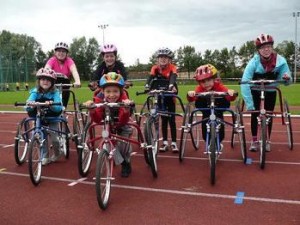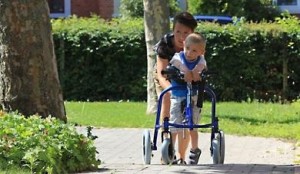For disabled children, mobility devices can mean a kind of freedom that would not otherwise be known. Mobility devices come in a range of forms however, with some, such as wheelchairs, being well-known, while others are more specific to certain conditions.
Walkers.
Swivel walkers are generally used by children  with certain conditions, such as muscular dystrophy and spina-bifida and are fitted especially for that individual. Swivel walkers are frames moved by the upper body strength of the user, essentially becoming a skeleton that allows movement. While these frames are useful for children who cannot sustain their weight using their legs, swivel walkers do not move quickly and are awkward to use.
with certain conditions, such as muscular dystrophy and spina-bifida and are fitted especially for that individual. Swivel walkers are frames moved by the upper body strength of the user, essentially becoming a skeleton that allows movement. While these frames are useful for children who cannot sustain their weight using their legs, swivel walkers do not move quickly and are awkward to use.
Essentially sharing a design with an overlarge baby walker, trainer walkers are effective at providing additional support when kids are learning to walk unaided. Designs vary and some trainer walkers may offer additional support, such as straps and pads, allowing a reasonable degree of safety for the user. Trainer walkers are adapted to the individual by experts, who adjust the height of the frame and the supports available. However, trainer walkers can become entangled in their surroundings, which presents a potential hazard and the design of trainer walkers often results in the dragging of feet, leading to awkward walking patterns developing.
Cycles and Scooters.
Handcycles are mobility devices operated by the user’s arms and have designs based on tricycles, with three wheels, including one at the front that is steered by the user. Different versions cater to a range of needs, for example, some hand cycles are available that are smaller than the average model, but features on all handcycles include chest straps and reverse braking for added stability and ease of use. Components of the handcycle that can be adjusted will generally include the seat and the footrest. A number of speeds allow the handcycle user the choice of a speed that is comfortable to them and appropriate to the conditions in which he or she is travelling.
Scooters, which typically run on batteries, allow a large degree of mobility. They can be used to access ramps and to mount small kerbs and travel at relatively fast speeds. Scooters come equipped with handbrakes and adjustable suspension, allowing users to feel very much in control of their mobility device. Scooters may not be for every disabled child, as they do require a large degree of independent coordination to operate.
Buggies and Wheelchairs.
A pushchair or buggy is propelled by an attendant  and provides supportive seating, including head support. Many pushchairs come with seats that can swapped out for bigger versions as the user grows, while the position of the child in relation to the attendant can be adjusted so that the attendant can check the user’s condition, if this is required. Pushchairs do need attendants for their operation, but are useful for parents who wish to draw less attention to their child’s condition.
and provides supportive seating, including head support. Many pushchairs come with seats that can swapped out for bigger versions as the user grows, while the position of the child in relation to the attendant can be adjusted so that the attendant can check the user’s condition, if this is required. Pushchairs do need attendants for their operation, but are useful for parents who wish to draw less attention to their child’s condition.
Wheelchairs are one of the most commonly seen forms of mobility device and may be pushed by attendants or be the user. As an alternative to a buggy, wheelchairs are useful as they enable the user to become adapted to a decent seating position and are typically cheaper. Larger wheelchairs are heavier but require less effort to propel and are therefore more suited to being operated by the user; these wheelchairs offer increased independence because they can handle kerbs and similar obstacles better than other devices. Wheelchairs for disabled children can be specially adapted to the user via a range of features such as leg and armrests and adjustable rear axles.
This guest post was written by Francesca, a freelance writer and blogger with an interest in children’s health. She currently writes for All Ability Cycling, who produce allabilitycycling hand cycles.
 Posts
Posts